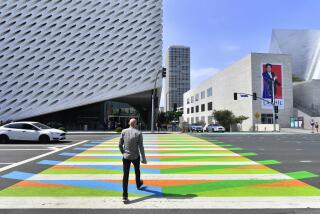Op-Ed: Angelenos dream of a new ‘citified’ Los Angeles, but will we be able to practice what we preach?
At some point in the not-too-distant future, the Broadstone Fairfax will open at the northeast corner of Fairfax Avenue and San Vicente Boulevard, adding 149 housing units, and their cars, to my neighborhood.
I’m wary of this project, but I don’t want to make a NIMBY argument. A development such as the Broadstone seems inevitable in the city that Los Angeles is becoming. This new L.A. is about density, verticality and even public transit. By 2023, Metro will open its Purple Line station three blocks north of the new building, at Fairfax and Wilshire Boulevard, across from Chris Burden’s lamppost project “Urban Light,” which has become a symbol, a landmark even, of a more “citified” Los Angeles.
Everywhere, we hear the rhetoric: L.A. is in the process of exchanging its old landscape of single-family homes and private life for a more concentrated streetscape. City Hall wants us to emphasize bikes and walking over cars. We’re paying to build subways and streetcar lines. Mayor Eric Garcetti’s Great Streets Initiative seeks to transform L.A.’s thoroughfares — or some of them — into “gathering places for Angelenos to come together.”
What such ideas promise is that we can somehow predict, and plan, the future, and that a city is less a matter of circumstance than of design.
The Broadstone Fairfax will only make a challenging set of corners more challenging. We aren’t envisioning ... a streetlife paradise anytime soon.
The Broadstone is emblematic of such designs and their discontents. As with any new structure, it lets us juxtapose the city as it is and the city as it will become. Besides generating money for its owners, it also embodies Future L.A. In the here and now, however, it is positioned at the flash point of three major streets — Fairfax, San Vicente and Olympic Boulevard.
I’ve long imagined this intersection as the Triple Junction, a reference to the most dangerous type of earthquake fault boundary, the point where three plates meet. As it turns out, city data show that this junction is not all that dangerous, but it’s still a ferocious, confusing traffic nightmare, especially late on weekday afternoons when San Vicente backs up nearly to Crescent Heights.
Many of us in the neighborhood anticipate that the Broadstone will only make this challenging set of corners more challenging. We aren’t envisioning the Triple Junction turning into a street-life paradise anytime soon.
Accomplishing such a transformation is easier said than done. For evidence, we don’t need to stray too far from the Triple Junction — or the Fairfax Asterisk, as it’s come to be called by a small group of community activists. Just three blocks south, for instance, the Great Streets Initiative has imposed traffic islands on Pico Boulevard. Whatever the city meant to do, the redesign has so far mostly diverted traffic from a main artery onto certain residential side streets.
I know, I know: Traffic is the great cliché of Southern California. It’s a “Saturday Night Live” sketch. But it is also a way to measure city life and the success or failure of making our streets “great.”
In 2014, the Los Angeles Department of City Planning unveiled Mobility 2035, one of L.A.’s blueprints for “expand[ing] the role of the street as a ‘public space.’” It offered these stats: “71% of trips in Los Angeles County are made by a driver alone in a car. 11% [of us] carpool, 12% take transit, and 6% of trips are by other modes (walking, biking).”
These are daunting percentages. To be charitable, they suggest we’ll be stuck somewhere between the old sprawling city and a new concentrated Los Angeles for a long time to come. We will plan for one reality and live another.
Or perhaps we won’t be planning as much as hoping. When Urban Light was first lit, in 2008, Burden described its inspiration: “I’ve been driving by these buildings” — the Los Angeles County Museum of Art campus — “for 40 years, and it’s always bugged me how this institution turned its back on the city.” But no one could have predicted how completely Urban Light would bridge that gap, how it would remake the boulevard.
Night and day on what was once a mostly desolate stretch of street, Burden’s artwork draws a crowd. Traffic slows to look. People walk through the lamppost array as if it were a contemplative’s maze; they take wedding pictures; they hang out after the museum closes.
Maybe the Broadstone Fairfax will provoke a similar set of changes, although apartment buildings are rarely social monuments. Maybe it will provide the impetus for us to rethink the Triple Junction, to fix the Asterisk. Like it or not, L.A. has to become a new city; there are too many of us here now for the old one to survive. We can believe in serendipitous urbanity, but we have to wait and see.
David L. Ulin is a contributing writer to Opinion.
Follow the Opinion section on Twitter @latimesopinionand Facebook
MORE OP-EDS:
The GOP’s message on guns: It’s not our problem, it’s God’s
What the Trump administration doesn’t understand about wildfires
More to Read
A cure for the common opinion
Get thought-provoking perspectives with our weekly newsletter.
You may occasionally receive promotional content from the Los Angeles Times.







